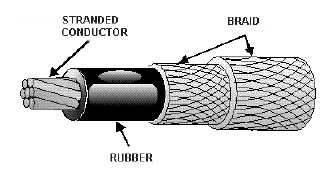1-21
Generally, except for overhead transmission lines, wires or cables are protected by some form of
covering. The covering may be some type of insulator like rubber or plastic. Over this, additional layers
of fibrous braid or tape may be used and then covered with a finish or saturated with a protective coating.
If the wire or cable is installed where it is likely to receive rough treatment, a metallic coat should be
added.
The materials used to make up the protection for a wire or cable are grouped into one of two
categories: nonmetallic or metallic.
Q29.
If a cable is installed where it receives rough treatment, what should be added?
NONMETALLIC PROTECTION
The category of nonmetallic protective coverings is divided into three areas. These areas are (1)
according to the material used as the covering, (2) according to the saturant in which the covering was
impregnated, and (3) according to the external finish on the wire or cable. These three areas reflect three
different methods of protecting the wire or cable. These methods allow some wire or cable to be classified
under more than one category. Most of the time, however, the wire or cable will be classified based upon
the material used as the covering regardless of whether or not a saturant or finish is applied.
Many types of nonmetallic materials are used to protect wires and cables. Fibrous braid is by far the
most common and will be discussed first.
Fibrous Braid
Fibrous braid is used extensively as a protective covering for cables. This braid is woven over the
insulation to form a continuous covering without joints (figure 1-15). The braid is generally saturated
with asphalt, paint, or varnish to give added protection against moisture, flame, weathering, oil, or acid.
Additionally, the outside braid is often given a finish of stearin pitch and mica flakes, paint, wax, lacquer,
or varnish depending on the environment where the cable is to be used.
Figure 1-15.—Fibrous braid covering.
The most common type of fibrous braid is woven from light, standard, or heavy cotton yarn. Cotton
yarn comes in different colors, which allows color-coding of the individual conductors. Cotton will not
withstand all the possible environments in which a cable may be laid. Other materials currently being
used to make fibrous braid are glazed cotton, seine twine or hawser cord, hemp, paper and cotton, jute,
asbestos, silk, rayon, and fibrous glass. The choice of which material to use depends on the strength
needed in the cable as well as how resistant it must be to its environment.
Fibrous Tape
Fibrous tape coverings are frequently used as a part of the protective covering of cables. The material
of tape coverings is made into the tape before application to the cable. The material in yarns for braid



